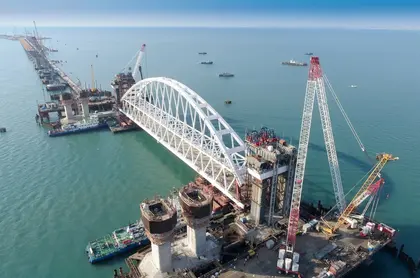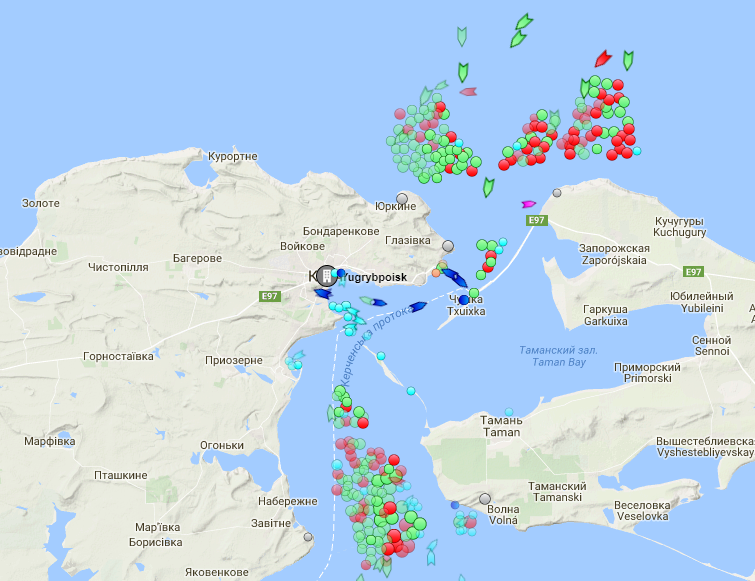Without permission from Ukraine, Russia on Aug. 29 successfully erected the first 6,000 ton railroad arched section of the Crimean Bridge under construction.
When completed by 2019, the 19-kilometer, $3 billion span will cross the Kerch Straight and connect the Russian mainland with the illegally seized peninsula.
Russian media have reported that this is the start of the final stage of construction of a vital piece of infrastructure from the Kremlin’s point of view. The options for getting to Crimea from Russia are not good now. Russians can travel there by plane or ferry.
Despite international condemnation and sanctions, the bridge if and when completed will also bluntly delive another Kremlin message to the world: Not only is the peninsula ours, so are the waters near it.
In order to settle the first arch of the bridge, Russia’s Transport Ministry closed the Kerch Strait for several days in August and will do so again in September and October.
However, the closure appears to be a new stage of Russia’s economic war against Ukraine.
New Stage of War
Russia first closed the strait on Aug. 9, then again on Aug. 28-Aug. 30.
The online vessels tracking maps on Aug. 29- 30 showed dozens of cargo vessels standing in lines on the both sides of a Kerch Strait, the 15-kilometer wide water channel, that connects the Black and the Azov seas between Crimea and the Taman Peninsula of Russian Federation.
Russia is going to continue closing the strait to first limit and then completely stop the export from the Ukrainian Azov Sea ports in Mariupol and Berdyansk, Andrii Klymenko, the head of the Maidan of Foreign Affairs, wrote in a column published on the nongovernmental organization’s website.
“In August, the Mariupol Trade Port managed to transfer only 160,000 tons of cargo with the average result of 350,000-400,000 tons a month due to Russia’s restrictions,” Oleksandr Oliynyk, the Mariupol Trade Port director wrote on Facebook on Aug.15.
Klymenko said the strait closure and size of the future bridge, especially its height, will damage Ukraine’s economy.
“The 35-meter high bridge will allow entering for vessels up to 33-meters high only. Thus about 30 percent of cargo vessels, that used to go to Ukrainian ports of Azov region, won’t be able to pass the strait,” wrote the expert.
In August Ukrainian exporters had to find the alternative ways to transport their goods and were forced to reorient their goods to the trade ports in Kherson, Mykolaiv and Odesa oblasts.
Ukraine’s Infrastructure Minister Volodymyr Omelyan told the Kyiv Post on Aug. 29 that during the first half of 2017 more than 480 vessels entered the Ukrainian ports Mariupol and Berdyansk through the Kerch Strait. Only 71 of them were sailing under the Ukrainian flag.
Russia in action
Russia started the Crimean Bridge construction in April 2015. The Russian Transport Ministry reported the bridge will be 19 kilometers long and cross Tusla Island in the middle of the Kerch Strait.
In order to speed up the construction, work is proceeding simultaneously in eight separate ares.
Russia plans to open four highway lanes of the bridge by December 2018 and the railroad part in 2019.
Ukrainian experts said that the Russian bridge practically closes another two Ukrainian ports in addition to those Kremlin took after it annexed Sevastopol and Crimea in 2014.
Russia’s President Vladimir Putin has been keeping an eye on the construction and frequently visits Crimea to monitor the situation.
The video, released on August 29 by the Official information website of the construction of the Crimean bridge, shows the settling of the first arch of the bridge. In order to settle the first arch of the bridge, Russia’s Transport Ministry closed the Kerch Strait for several days in August and will do so again in September and October.
In 2016, Turkish bulk carrier Lira accidentally hit and destroyed several of the newly constructed bridge pillars.
However, in March Putin told journalists that construction was going well and maybe the bridge will be opened even “sooner than everyone expected.”
Mariana Betsa, Ukraine’s Foreign Affairs Ministry spokesperson, told tne Kyiv Post on Aug. 28 that Ukraine sent a note of protest to Russia in July because of the Kremlin intentions to close the strait.
According to the United Nations’ Convention on the Law of the Sea, Russia had no right to start the construction and close the strait without Ukraine’s official permission. “Ukraine filed a claim to the International Sea Arbitrage against Russia for illegal construction of the bridge. The court process will take place in 2018,” she said.
Russia also had no right to place limitations on vessels to enter the strait.
Alexey Kravchenko, Sea and River Fleet of Russia spokesperson, told the Kyiv Post on Aug. 28 that heavy cargo vessels won’t be able to pass the Crimean Bridge not because of its height, but because of the shallowness of the Kerch Strait. Only vessels with 8 meters’ draft can pass and enter the Azov Sea.
“So please stop saying that nasty Russians close the Azov for you,” Kravchenko said.
However, when asked, how giant, 50 meter high cargo vessel Panamaxes, with 9-14 meters’ draft, managed to enter the Mariupol Port, Kravchenko responded that it was a Ukrainian experiment in 2011 and Panamaxes entered the Azov sea half empty.
Shota Khadjishvili, the former CEO of Risoil agrarian holding based in Chornomorsk Port, told the Kyiv Post on Aug. 28 that Ukraine’s part of the Azov Sea is deeper than the Russian one.
That allowed Ukraine to accept Panamax vessels, load them half and then finish the loading in one of the ports of the Black Sea.
Surviving
After Russia annexed Crimea in 2014, Mariupol Port undertook the cargo traffic from Crimean ports. The international sanctions forbade business with the ports in annexed Crimea.
Oliynyk wrote that the Russian restrictions in Kerch Strait were pretty disturbing not only for Azov ports but for the whole Ukraine’s society and business.
In August main business partners of the Mariupol Trade Port –Mariupol’s metal plants were forced to reorient their product for export to the southern ports (Odesa, Kherson, Mykolaiv), Oliynyk wrote.
“Due to the height limitations of the Crimean Bridge Ukraine can lose more than 30 percent of large-load cargo vessels,” Oliynyk said.
However, not only metal producers but also the agrarians left Azov region to export from the Black Sea ports.
Volodymyr Osadchuk, the head of the Ukrainian branch of the Cofco agrarian corporation, that had built a plant near Mariupol Trade Port told the Kyiv Post on Aug.28, that the international business was forced to move its export capacities out of Mariupol Port.
“In the past to enter the Kerch Strait every vessel had to pay a special fee to the Kerch Port, the main authority that managed the strait. However, since 2014 it was included in the Crimean sanctions list. So it is against the law to pay them,” Osadchuk said.
Klymenko said some Ukrainian ships are still illegally paying to Kerch for the right to pass the strait.
“But the foreign cargo vessels, going to Mariupol and Berdyansk ports, now pay to Russians. They do so in order not to violate the international and Ukrainian sanctions,” the expert explained.
“The shipment agents of Ukraine’s ports located on the coast of Azov Sea always warn their clients to do so.”
Kravchenko confirmed his words, saying the businesses prefer to send money for entering the strait to Russian firms and state agencies, like RosMorPort federal sea fleet agency.
Economy struck
Omelyan said that the bridge will damage the quality of the agrarian logistics of the Azov region.
As all the cargo carriers would have to meet size approvable for Crimean Bridge. This will force the exporters to reorient to the Black Sea Ports. As the result, the grain terminals in ports would not be loaded in full capacity.
“Only the UkrTransAgro grain terminal, located in Mariupol port would lose approximately $ 1 million a year because of that,” Omelyan said.
The ministry counted that only Mariupol Port will lose more than $5 million until the end of 2017.
Ukraine’s Azov ports could also lose 30 percent cargo traffic with such destinations as the U.S., Middle East, Great Britain.
Omelyan said Ukraine must respond to Russia by informing the European Union, the United States and other countries supporting sanctions.
Ukraine should ask its Western partners to widen the sanctions list and include the companies and people, involved in the bridge construction, in it.
Russian construction company StroyGazMontag, which belongs to the Russian oligarch Arkadiy Rotenberg has become the project coordinator and the general constructor of the Crimean Bridge. In 2014 Rotenberg was included in the EU sanctions list.
You can also highlight the text and press Ctrl + Enter





